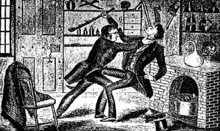Two invaluable dental forensics equipment tools that we can’t live without
Today we have wonderful dental inventions such as the NOMAD eXaminer™ and NOMAD Pro 2™, hand-held x-ray machines (shown, courtesy ForensicDentistryblogspot.com) that can be used in places where traditional x-ray machines are impractical. The NOMAD got its start in forensic dentistry, first being used to identify victims of the 2004 tsunami disaster in Thailand. Today, they are seen as valuable forensics x-ray tools.
Unfortunately, a NOMAD was not available to the dentists of Harvard Medical School in the early 1800s.
Humble beginnings of pre-modern dental equipment
Now we take forensic dentistry for granted, but in the early 19th century, it was in its infancy. A celebrated murder case in 1849 centered around the finding of a denture for victim identification. If not for that, an innocent man might have been hung for the crime. This was the first case of a dentist in giving an expert testimony in courts of United States, according to U.S. National Library of Medicine
National Institutes of Health.
George Parkman, I barely knew ye!

Dr. George Parkman, owner of millions.
The victim, George Parkman, was a rich, generous and respected Boston physician, who failed to return home for dinner one evening in November of 1849. A large search began and 28,000 handbills were printed. The pricey sum of $4,000 was offered as a reward for his recovery, dead or alive. The first clue to his whereabouts was discovered by a janitor at the Massachusetts Medical College (now Harvard Medical School). The clue consisted of burnt-up bones, a dental prosthesis, and melted gold; all found in an assay furnace. Also found were mutilated human remains buried in a tea chest – a headless torso and thigh, but no head to identify the body. They were all in the chemistry department laboratory overseen by Professor John White Webster. Webster was arrested and indicted for the willful murder of Dr. Parkman, with Webster claiming the janitor who found the gruesome remains was the culprit. The trial hinged on identifying the remains as those of Dr. Parkman. The artificial teeth were the only useable evidence, as there was no DNA testing in those days.
Finding the Evidence they needed

John White Webster, convicted murderer.
It was established at the trial that Dr. Parkman had lent Webster money since 1842, despite the fact that Webster had yet to pay him back. It was alleged that Webster lured Parkman to the lab on the pretense of paying off the debt, attacked Parkman with a knife, killing him, and then mutilated the remains and burned all the identifiable body parts in the furnace. The denture was all that was left.

The murder, as imagined some years later.
The parade of witnesses was a Who’s Who of early 19th century dentistry. Nathan Cooley Keep, Dr. Parkman’s dentist, had made the mineral teeth found in the furnace and showed that the denture fitted into a plaster mold he had made of Parkman’s jaw. W.T.G. Morton, inventor of ether, testified for the defense, claiming the teeth were not Parkman’s. Charles Thomas Jackson, MD, later to become an enemy of Morton’s, testified to the amount of gold recovered from the furnace. Even Oliver Wendell Holmes (then professor of anatomy at the school) made an appearance on the stand, discussing body dissection.
I want the tooth! You can’t handle the tooth!
Over 120 witnesses were called before the case went before the jury. It took the jury three hours to return a guilty verdict. Webster was sentenced to death by hanging and executed in August of 1850. Before his execution, he repented of his crime and apologized for having accused the janitor who had found the evidence. If the false teeth had just been lying in the furnace and not in the victim’s head, they would have burned up with everything else and John White Webster would have walked free of a dastardly crime.

